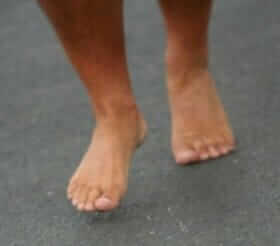The Bare Facts About Barefoot and Minimalist Running by Jo Brielyn
Have you ever seen people in the gym or in your neighborhood exercising barefoot or roaming around town in their five-toe shoes and thought about kicking off the shoes for your next run or workout? The concept is nothing new. In fact, history shows that people have been running barefoot for centuries. The reentry of the barefoot style into modern athletics over the past 30 or 40 years, and more specifically in marathons and Olympics, has caused surges of popularity and interest once again.
So what is barefoot or minimalist running? Barefoot running, also known as minimalism or natural running, is as simple as it sounds. It is running without shoes or running in thin-soled shoes. But it’s not just an issue of what is or isn’t on your feet. It is also about how your foot strikes the ground. Here are some bare facts and a few pros and cons to help you decide if this running style might be a good fit for you.
Pros:
— Running barefoot or in minimal footwear strengthens the muscles in your foot, especially in the arch. A strong foot is a healthy foot and is less likely to pronate (or turn out in an unnatural position) or to develop a collapsed arch.
— The forefront style required for barefoot running forces you to focus on landing more lightly and on the balls of your feet, instead of on the heels (rear-strike style). This reduces the amount of impact on the body and decreases the risk of injury to your feet.
— Running barefoot or in minimal footwear (lighter than traditional shoes) has been shown to use about 5% less energy than shod running. The forefoot strike required for this style of running uses the natural springs in your foot and calf muscles more to store and release energy. That means there is less mass to accelerate at the end of your leg with each stride.
Cons:
— Shoes with thick soles are much more forgiving if you run over sharp objects, glass, etc.
— If you are naturally a heel striker (meaning you land with your heel first when you run), it will take some time and work to adjust and train your body to forefoot strike, which is necessary for proper form when barefoot running. Runners may be at greater risk of developing Achilles tendonitis when they switch from heel striking, until they get a firm grasp on the technique.
— Barefoot or minimalist running requires stronger feet and calf muscles. It may take time for you to work up to strengthening those muscles before you get back to your previous running distance and regimen.
Easing into Barefoot Running with Minimal Shoes
Until you develop good barefoot running form and build up calluses on your feet, it is advised that you wear minimal footwear. Minimal running shoes are a great option for runners who want to run barefoot but also wish to protect their feet from rocks, dirt, and other hazards. The thin, flexible nature of the shoes imitate barefoot running while offering some protection for the soles of your feet.
Many reputable athletic shoes companies such as Vibram, Nike, New Balance, Saucony and Merrell offer minimal running shoes that offer features that allow you to forefoot strike properly. Minimal shoes should not have a built up heel. If the heel of a running shoe is too large, you will have to overpoint your toes to forefront strike, which could lead to pain or foot injury. Also, look for minimal shoes that have a flexible sole and no arch support. A stiff sole and arch support don’t allow your arch to flatten naturally and prevent your foot muscles and ligaments from functioning the way they are designed to work. If you cannot twist and bend the sole of the shoe easily, it is most likely too stiff.
In the beginning, you will find that your foot muscles are worked out harder and more tired, but over time those muscles will become accustomed to the progressive training and will grow stronger. For the first few weeks, remember to also carry your traditional footwear with you as a backup. If you feel the need to stop in the middle of a workout, change into the cushioned running shoes and continue with your activity. It will take time to adjust.
Proper Forefoot Strike and Knee Drive
Whether you choose to run barefoot or minimalist, or stick to running in standard running shoes, watch this video by Born To Run Coach Eric Orton to help you understand proper run form. In it, he discusses and demonstrates helpful information about the proper foot strike and knee drive needed for good run form and to avoid over striding.

JO BRIELYN is an author and contributing writer for Get Fit Now and has currently completed 16 nonfiction books about health and wellness. Jo is the founder, writer, and editor of Creative Kids Ideas, a resource website that supplies parents, teachers, and family members with the tips and fun ideas to help build stronger, happier, and more creative kids. She is also the writer behind Good-For-Your-Health.com. Jo is a veteran of the United States Air Force and a former youth leader. She resides in Central Florida with her husband and their two daughters. Jo is the co-author of Combat Fat for Kids.





